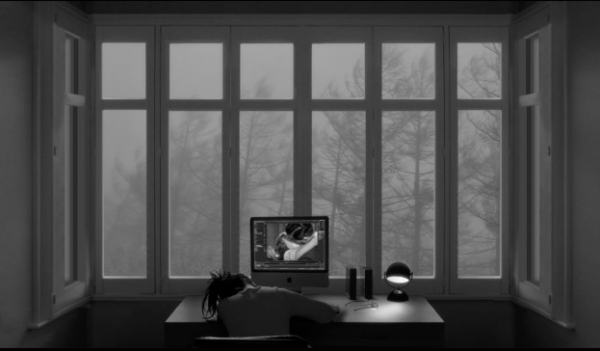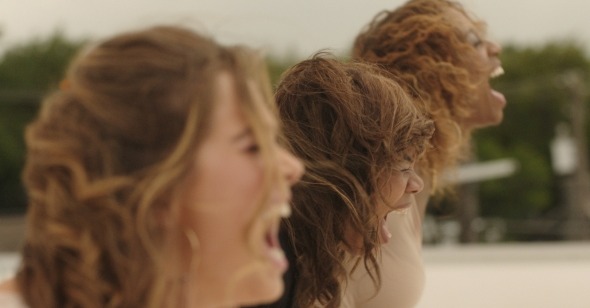Best (?) Ensembles: Support the Girls and The 15:17 to Paris
It seems counterintuitive to pair a fleet, heartfelt ensemble piece about work and empathy with a high-wire acting experiment that astral projects into the uncanny valley, yet here we are: both Andrew Bujalski’s Support the Girls and Clint Eastwood’s The 15:17 to Paris exude a comparably impressive level of trust in their actors. Support the Girls is structured by unpredictable emotional detours and escalations, all of which a brilliantly nuanced Regina Hall must absorb while managing and nurturing her staff, for whom she acts as a human shield against a daily grind of casual racism and sexism. It relies on the chameleonic anonymity of “character actors” rather than star personas: the story would collapse on itself if its performers could not believably substantiate and shoulder its depiction of mental and physical labor—which, to a great extent, involves performance and masking. At a detailed but breakneck 90 minutes, throwaway lines must incisively message subtext; hardly an expression, an exhalation, or a tonality is wasted. But when the film pauses, the performers deepen the silence. In one telling, sweet non sequitur, Hall sits outside, and, letting her defenses down, calls out to birds flying overhead.
The 15:17 to Paris, on the other hand, is a bizarre mélange that defies words like “uneven” or “successful.” It studies the idea of playing oneself, with non-actors Anthony Sadler, Alek Skarlatos, and Spencer Stone appearing in a dramatic adaptation of their own true-life thwarting of a terrorist shooting onboard a train in France. Its opening chapter, a sort of origin story sequence, introduces them as children played by young actors, before the real-life trio is air-dropped into the narrative alongside the same people who played their parents in flashback, cosmetically unchanged to account for the time cut (watching these men call Judy Greer or Jenna Fischer “mom” is pure Brechtian edginess). It’s palpable that they are trying to perform for Eastwood’s story: self-consciously, imperfectly, but in an effort to be faithful to some version of something that they lived. The train sequence succeeds most conventionally on the rubric of classical narrative seamlessness, with each guy locking into an action hero interpretation that feels integrated into a familiar genre format. But the fact that its buildup consists of stilted, banal, and often quite funny Eurotrip scenes twists those recollections into something hyperreal. Intentional or otherwise, these collisions make the film one of the most mesmerizing and discomfiting experiences in recent memory. Both films are preoccupied with finding some truth in experience: one making brilliant use of a conventional repertory toolkit to do so; the other shattering authenticity with an uncontrolled and often tense conceit. In both of those settings, there’s also a sense of good faith that their performers can lead the way. —Chloe Lizotte
Best Musical: Jeannette, the Childhood of Joan of Arc
Mary Poppins, Freddie Mercury, Ally Maine . . . Joan of Arc? Seemingly out to conquer every maligned genre under the sun, French misanthrope turned cinematic court jester Bruno Dumont took on perhaps his greatest challenge yet with Jeannette, the Childhood of Joan of Arc, an outrageous and inspired musical restaging of the early years of France’s most famous martyr. For Dumont, no time-honored tradition is too sacred: Who needs chops when you have heart (not to mention the spirit of the Lord coursing through the soul of your main character)? Who needs the magic of movies when you have a pair of dancing nuns? Liberated from the constraints of art-house austerity, Dumont has found fresh ways to energize stale formulas, with Jeannette standing as arguably the most singular and focused of his recent comedic dalliances. And in Lise Leplat Prudhomme, the younger of the film’s two Jeannettes, he’s found a Joan to stand alongside those of Falconetti and Bergman. Singing and swaying her way into the foreground in the film’s opening shot, she arrives like a vision, fully formed. Et voilà, a star is born. —Jordan Cronk
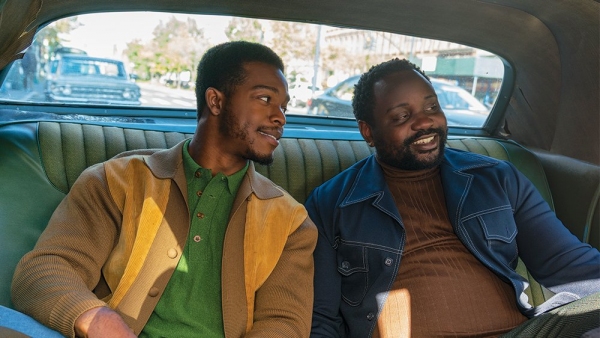
Best Supporting Actor: Brian Tyree Henry
If the mark of a great supporting actor is an ability to create lives in miniature, using a few pages of dialogue and a handful of shooting days to signal the complexity and completeness of a life that one’s lead peers have an entire movie to evoke, then it’s difficult to imagine a more valuable one from this past year than Brian Tyree Henry. Henry doesn’t exploit his abbreviated material for maximum impact or lunge for attention, but rather inhabits his briefly glimpsed personages to the fullest. In Spider-Man: Into the Spider-Verse, Henry invested weary, conflicted emotion in the poignant apologies of the hero’s patrolman father. In Widows, he brought dapper venality to the underutilized role of a Chicago kingpin-turned-politician, cutting his miscast scene partner Colin Farrell down to size with one flick of his steely gaze, making him look every bit the empty suit. However, these films were just precursors to the main event: Henry’s 12-minute performance in If Beale Street Could Talk as Daniel, a recently incarcerated man still traumatized by the horrors of his years behind bars. Any actor worth his salt can make do with the sublime eloquence of both Barry Jenkins and James Baldwin. Henry’s vocal delivery is exquisite—there’s a world of thought in each word he utters—but it’s the silent physicality of his approach that allows him to transcend the shortness of his screen time. He knows and trusts in the expressive power of a purposeful pause and the unspoken depths that a performer can summon through stillness; when Daniel goes quiet, lost in a memory too terrible to put into words, Henry, stock-still in invasive close-up, opens up a portal into the bottomless desolation of a man who has lost the will to be outraged, shamed into silence by a world that has rendered his outrage futile. That the actor filmed these projects more or less consecutively with his stereotype-burning tour de force on Donald Glover’s Atlanta, his Tony-nominated turn in Kenneth Lonergan’s Lobby Hero, and bit parts in movies like Hotel Artemis and White Boy Rick heralds the arrival of a new master, one deserving of a spotlight all his own. —Matthew Eng
Best Mise-en-scène: Unfriended: Dark Web
One of the most terrifying things about living a life on social media is the feeling of constant exposure—the sense that hiding behind avatars and pseudonyms and Skype chats and Twitter feeds has somehow, conversely, made us more vulnerable. It’s not necessarily that we’re always being watched—it’s that we now constantly feel seen. Scarier, funnier, and more narratively clever than its already impressive predecessor, the latest in the Unfriended franchise (please let there be more!) exploits this strange paranoia. Like Game Night with an added layer of nerve-jangling, real-world danger, Dark Web raises the stakes and then some, charting in real time the emotional and physical destruction of a relatively pleasant young man who, we come to realize, has made one fatal error: absconding with a laptop at a café that hadn’t been claimed. He and his affable roundelay of friends thus become the pawns in an elaborate deadly con that takes them deeper and deeper into moral darkness and physical danger. That all of this takes place on one screen in one allegedly unbroken take (a meticulously constructed trick that gives off the sense of unceasing, single-minded flow and panic), told through Facebook chats and Skype groups and sinister videos buried in secret folders, makes the whole thing feel both narratively urgent and a genuine reflection of 21st-century screen addiction. —Michael Koresky
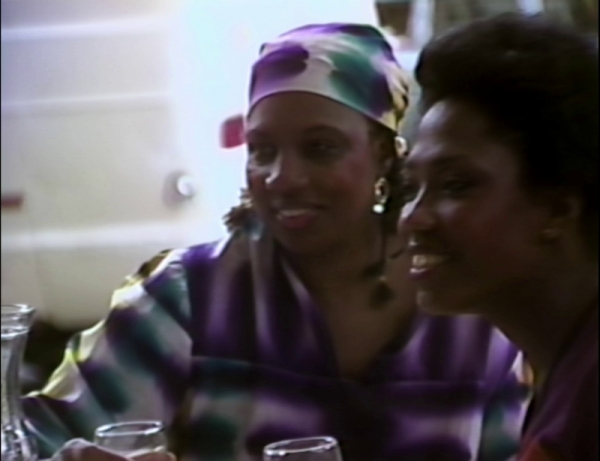
Best New Old Movies
1. The Other Side of the Wind
“Netflix presents… An Orson Welles Picture.” Thus begins The Other Side of the Wind, suggesting the odd image of the larger-than-life wunderkind of 20th-century Hollywood and the 21st-century’s one company industry-unto-itself traveling through time to rendezvous in the fashionably bleak atmosphere of late ’70s L.A. As in many of Welles’s pictures, the narrative is pieced together from the fragments of a fallen idol; but true to the film’s fixation on proliferating cameras, each with an angle of its own, The Other Side of the Wind reduces its legendary director figure Jake Hannaford (John Huston) to a dyspeptic member of his own Greek chorus. Cut by Bob Murawski with little regard for temporal continuity, the film takes the form of a hyperverbal fugue, with the makeshift community at Hannaford’s party coming across like a single consciousness doing battle against itself. One of the Welles movies inclined towards instability—more Mr. Arkadin or The Trial than The Magnificent Ambersons—The Other Side of the Wind is centered on manifold conflicts. These take place both within the story and on the level of form, with a dissonant jostling of competing film stocks, aspect ratios, and layers of fiction, ultimately amounting to a bad vibes confrontation between the very real hang-ups of the old generation and the much longed for, possibly illusory freedoms of the new. Welles set out to document an end of an era, but the strange liminal moment he captured might not yet have passed. —Daniel Witkin
2. Personal Problems
For me, 2018 was the Year of Bill Gunn: I spent so much of these past twelve months in awe of his work and cursing the system that suppressed it for so long. I don’t seek to paint him as some unsung hero of Black cinema or tragic figure unable to see the impact of his filmmaking during his lifetime. I am, however, here to fully sing the praises of a genius. Although created in collaboration with Ishmael Reed for public access TV in the late 1970s, Personal Problems was only given a proper release this year after languishing on videotape, at the time a new form and an accessible tool for storytelling. A Black soap opera following the life of Harlem Hospital nurse Johnnie Mae Brown, this is a work of ingenuity, part docudrama, part music video, with sprinkles of absurdity throughout; the by-any-means necessary approach to the filmmaking and limitations of the format on which it’s shot lend it an experimental feel. We see Johnnie Mae at brunch with her girlfriends, drinking wine, cutting up. They talk about love, their hospital jobs, and their finances. The overlap in conversation seems too organic to be written, offering a rare instance in which we’re allowed to see Black female characters outside of a gaze that presumes to know our innermost thoughts. Then there’s the conversation at the breakfast table, in which she, her husband, and her father-in-law try to recall the playwright and plot of A Raisin in the Sun; it’s a botched attempt at a teachable moment before her husband squanders his own hard-earned dough in a business venture. “I ain’t never heard of no raisin’ in no sun!” Personal Problems is a piece of work that seeks not to be the Black version of anything but a world in and of itself, which only someone named Johnnie Mae Brown could occupy and share with us. —Tayler Montague
3. Eight Hours Don’t Make a Day
Arriving stateside over four decades after its initial broadcast on German television, Rainer Werner Fassbinder’s Eight Hours Don’t Make a Day made the year’s slate of U.S. theatrical releases look even more paltry than usual. Comprised of five episodes running a total of eight hours, the miniseries was made after the director's pivotal discovery of Douglas Sirk’s melodramas, during a period of creative efflorescence that produced The Bitter Tears of Petra Von Kant (1972) and Ali: Fear Eats the Soul (1974). No less formally accomplished or gloriously realized than those masterpieces, Eight Hours also has the distinction of being Fassbinder’s most optimistic work, touchingly hopeful regarding man’s capacity for betterment. Bearing the subtitle “A Family Series,” it’s an unmistakably popular entertainment that concedes nothing in terms of cinematic construction, making it clear that boundaries of taste—between, say, TV melodrama and avant-garde theater—are perhaps not so insurmountable after all. Of this, there’s no better illustration than the tour de force, half-hour wedding celebration that concludes Part IV. (Among other things, it contains, after Bitter Tears, yet another superb use of “Smoke Gets in Your Eyes.”) In the span of a workday, Fassbinder creates the work of a lifetime. —Lawrence Garcia
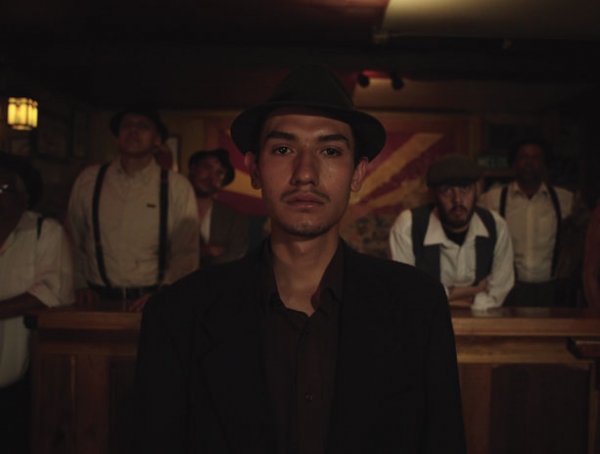
Best Movies That Every American Needs to See Right This Second (So Where Are They?):
Bisbee ’17 and El mar la mar
Remember last week, when our highest-ranking executive wanted to address the nation with his usual scurrilous stream of scare tactics and racist falsehoods, and the networks seemed tentative about allowing so much as a rebuttal or a fact-check? Rather than have one or, as it eventually happened, two speakers from the other party respond, I'd have been just as happy to see Robert Greene’s Bisbee ‘17 or Joshua Bonnetta and J.P. Sniadecki's El mar la mar beamed into every U.S. household. These two border-focused documentaries don’t just evoke entirely divergent histories, ideologies, and dare-I-call-them facts from what 45 set forth (or ever sets forth). They also embody totally different templates for how you persuade someone, how you contemplate a place and its legacies, how you engage other people's mindfulness, how you hold a space authoritatively without pretending to have all the answers, how you insist: “We've been here before!”
Bisbee ‘17, with its intricate blendings of vérité and reenactment, and El mar la mar, with its poetic refusal of exposition and its eccentric relations of sound and image, furnished stunning rejoinders this year not just to our elected propagandists and hapless morning-show ringleaders but to more timid forms of documentary that continue to reap commercial and critical fortunes. It's okay, and in many cases preferable, if the “truths” you learn from nonfiction cinema are emotional as well as archival, or if one central truth is that most stories worth telling live amidst a perpetual jostle of competing perspectives. Bisbee, the year's best movie about who will or won't be whose neighbor, tracks what happens as a once-thriving Arizona mining town restages a historical episode of xenophobic, racist, and anti-Left purging, which eventually found brothers packing brothers into boxcars and launching them out of Bisbee into a barely survivable desert. Exhuming this incident as living theater alternately solidifies and undermines different people’s (or sometimes the same people’s) certainties about what to think and feel. A final, climactic exit marks both a crystallized act of protest and a helpless, ineffable buckling under too much past and too much present. El mar la mar refuses to show us faces of the recent border crossers, the border patrols, the borderland residents, the checkpoint detainees, and the other eyewitnesses of that ever more overdetermined tract of American landscape and mindscape; blocked from relying on semiotics of appearance, the audience must really listen to these testimonies, hanging on every narrative turn, every inflection of ambiguous sympathy. Meanwhile, the sun-blasted objects onscreen, backpacks and sunglasses and water bottles lensed in situ in the Sonoran desert, incline oppositely: visually evocative, intractably mute, surviving footnotes to memoirs already lost.
These movies should be playing everywhere. For now, because of our feeble infrastructures for showcasing documentary (especially when executed so adventurously), they are virtually nowhere. Watch the skies in 2019 for news of streaming releases . . . or, in the spirit of action, maybe write to a filmmaker or distributor or librarian or nearby programmer and figure out how to get these much-needed texts into your town, and under local discussion. That’s what I did. Be the change you want to see, people! —Nick Davis
Most Misleading Title: Lean on Pete
Least Misleading Title: 24 Frames
Most Irritating Camera Lens: The Favourite
Extreme wide angle lenses are not categorically awful. Probably the best use of a fish-eye lens is, fittingly, 2012’s GoPro-shot Leviathan, in which the effect is purposefully disorienting, plunging the viewer into the alien world of deep sea commercial fishing as experienced at a fisherman’s wrist, flung across a slimy deck, or lifted by a pole into a cluster of chum-mad seagulls. What can an extreme wide angle do for a “fun” but ultimately flat period drama filled with lusty intrigue, female rivalry, the machinations of state power, and some quirky animal stuff? The answer is nothing. Not that such a lens couldn’t work; it’s just that Yorgos Lanthimos doesn’t do anything remotely interesting with it. If lenses could talk, the 6mm one used in The Favourite might say something like this: “Hey!! Look at me!!! Look at these beautiful people! I scrunched everyone up so that they’re UGLY. You like it?? I’m DIFFERENT! Look at this palace! It’s so big and weird, like rich people’s houses are. I WARPED it. Get it??!! Because this is a WARPED WORLD. BOOM.” —Genevieve Yue
Most Nauseating Cinematography: At Eternity’s Gate
One would have assumed that Julian Schnabel’s experiments with perspective and trammeled camera movement would have reached their natural end point with The Diving Bell and the Butterfly, in which we’re wedded to the point of view of a man with locked-in syndrome. Alas you know you’re in trouble from the start of his Vincent van Gogh biopic when he and his DP Benoit Delhomme introduce us to a shepherdess in a sun-dappled field; through van Gogh’s eyes we see her through a yellow-tinted bifocal that has the effect of making half the screen look like it’s been dunked in piss. (Is this how an artist sees?) Just a little later, the camera is bobbing and weaving indiscriminately, in and out and around Willem Dafoe’s van Gogh and Oscar Isaac’s Paul Gauguin as they carouse on the streets of Arle, which has the effect of making actors trying to act “period” seem like they’re trying to avoid being clobbered on the head by the camera. (Is this how an artist feels?) Schnabel’s film is admirably preoccupied with light and texture and the experience of an artist’s work, though the camera tricks prevent it from being at all immersive, making one yearn for the painterly reverence of Minnelli or the perverse borderlines of Pialat. —MK
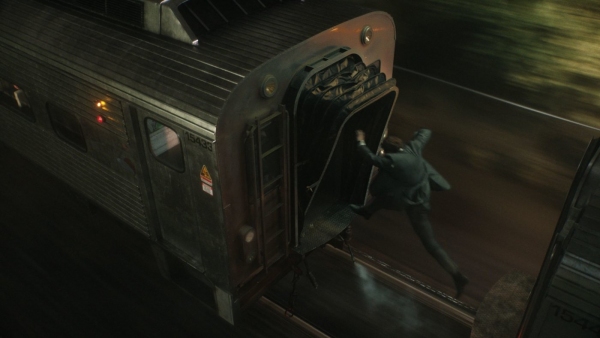
Best Action Sequence: The Commuter
It’s always a treat when a new Mission: Impossible film arrives in theaters. What better summery confection is there than our most successful ongoing cinematic action franchise continually allowing our best ongoing action star new ways to exercise his obvious self-loathing death wish? That said, even though Mission: Impossible—Fallout arrived on time in late summer and Tom Cruise was appropriately bruised and battered about, all of its set pieces (even a quite insane bit with small helicopters) had already been topped way back in January at the climax of Jaume Collet-Serra’s The Commuter, which sends a Metro-North passenger train careening off the rails. The geometric precision in the interplay between the compositions and editing would please Eisenstein, and the overall effect of its perfection is so gleeful that I practically barked and clapped at the screen like a hungry seal. I could spend time talking here about how, sure, part of the scene’s impact comes from the ways in which Collet-Serra and muse Liam Neeson cleverly build our overall investment in the fate of that train and the people on it over the course of the film’s tense and taut opening acts, but that shit’s boring, and crashing trains together, sending them end over end with sparks flying into the night—now that’s entertainment. Maybe someone in Hollywood could put Tom and Jaume together for a lunch? Just to see what happens? —Jeff Reichert
Best B: Upgrade
In the recent emergence of Brawl on Cell Block 99 director S. Craig Zahler and the snowballing cult success of Christian Gudegast’s 2018 pinch-me-because-this-is-somehow-good heist flick Den of Thieves, one senses a dawning realization. Perhaps it’s that audiences for what is commonly termed “trash” are by and large more intelligent, observant, and demanding than those who prefer crashingly predictable blockbusters or flaccid, piss-weak “prestige” genre fare like Widows. The latest exhibit to be submitted in evidence is Upgrade, from Australian writer-director Leigh Whannell, co-creator of Saw and the markedly less insidious Insidious franchise. Whannell has jacked up his M.O. (grand larceny of existing ideas palliated by relentless, pleasure-spurring invention; layered thrills boosted by wrenching emotional conflict) and launched it into the agglomerated realm of (im)pure genre, the once fecund territory of the grindhouse B movie. Right from the spoken opening titles—perhaps a nod to Orson Welles, whose films were sometimes B pastiches (Mr Arkadin) or released as real B pictures by studios who wanted them to disappear (Lady from Shanghai, Touch of Evil)—you sense you’re in for something a little stronger, in every sense, than your usual action-thriller fare. Set in Chicago in what feels uncomfortably like the very near future, it’s an obstreperous and dauntless mash-up of The Bonfire of the Vanities, Hard Target, eXistenZ, Death Wish, The Passion of Joan of Arc, 2001: A Space Odyssey, The Six Million Dollar Man, and Knight Rider. Gurgle with satisfaction as Whannell exorcises man’s relatable A.I. paranoia by dispatching his protagonist Shay (Tom Hardy-alike Logan Marshall-Green) on a sanguinary rampage with the help of an internal talking computer called “Stem” implanted in his spine, ostensibly to help relieve the symptoms of his bad-guy induced paraplegia. He’s not a robot—the human brain is making all the decisions—but he occasionally needs Stem to get him out of a spot, by taking over the controls and committing progressively Jacobean acts of atrocity on his behalf, much to Shay’s recoiling, “I’m-so-sorry-about-all-this” chagrin. The rare B that has the courage to try and do something genuine with a piece of indulgent dross, it features a quite ingenious “analogue vs. digital” car chase and the most coherent triple twist ending since Diabolique. It’s funny and brutal and sincere. —Julien Allen
Best Heterosexuality: If Beale Street Could Talk
The heartbreaking tale of Tish and Fonny is one of lovers caught up in the gears of the pitiless American mechanism of racism, their pure, deeply felt romance unable to exist in a drab, resentful, and hostile society that won’t let them be. In adapting James Baldwin’s book, Barry Jenkins wisely doesn’t let their tragedy be the story of them: one is unlikely to leave If Beale Street Could Talk without still being high on the fumes of Tish and Fonny’s erotic bond. The scene depicting the consummation of their love is so sexy I was thunderstruck by the realization of how long it had been since an American film was remotely interested in its actors as sexual beings. Their bodies, their flesh all move to the rhythms of a rainstorm and Miles Davis; he covers her naked body with a sheet in loving care, and she and we look at his beauty with awe (Jenkins’s doesn’t abandon his queer fan base following Moonlight: the first, exquisitely lit shot of Stephan James’s Fonny stripping to his white briefs was the most welcome bit of male objectification in 2018 cinema). The tenderness with which Fonny takes Tish to his bed has an opaque narrative purpose—when he is summarily accused of rape, it is impossible for the audience to believe this lover is capable of sexual violence. But the scene also stands alone, allowing us to luxuriate in the actors’ physicality as much as their emotional travails. —MK
Worst Heterosexuality: Fifty Shades Freed
The biggest letdown of the occasionally clever and knowing Fifty Shades series has been its erotic coyness; its supposedly kinky sex has always come across as haplessly square—like butt plugs straight from the Pottery Barn catalog. While each episode has been at its most engaging when teasing the possibility that Anastasia Steele (Dakota Johnson) might walk away from Christian Grey (Jamie Dornan), the genetically perfect, richer-than-God Seattle dweeb with control issues and an indeterminate accent, they’ve been uniformly bad at generating convincing sensual intimacy, putting its mildly charismatic stars through their mechanical paces with goofy Ben Wa balls and spreader bars. In the most off-putting of the final—and worst—installment’s many unappealing set pieces, Anastasia turns the tables on dumdum dom Christian by, wait for it, drizzling Ben and Jerry’s on his chest and abs and licking it off. I prefer to believe the flavor was Chunky Monkey. It’s just one more crazy stop on the way to fetish paradise, culminating in its normiest moves of all: matrimony, parentage, and servile womanhood. At least all this envelope-pushing is finally over; I can no longer take the transgression. —MK
Best Neithersexuality: The Wild Boys
Robert Louis Stevenson meets James Bidgood in French experimental filmmaker Bertrand Mandico’s phantasmagoric first feature, which ships a band of nasty, disobedient schoolboys off to a displeasure island as punishment for bad behavior. There, the little savages are exposed to toxic plant life, which literally transforms them into females—a climactic twist that might not come as much of a surprise considering that all of these boys erased are played by adult women. The resulting film is even stranger and more deliriously gratifying than this description could infer, a work of boundless imagination in which not only is gender not fixed, it’s barely a matter of fact. A dense thicket of sounds, superimpositions, and in-camera effects, shifting between black-and-white and color, The Wild Boys is both liberation and horror, anarchic and highly constructed, brave in its focus on the body as both erogenous and alien zone. —MK
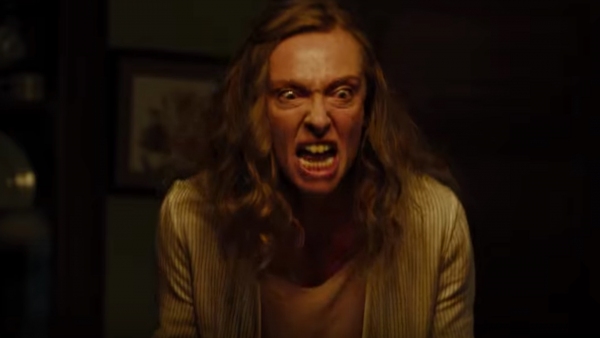
Best Monologues: Toni Collette in Hereditary
In Hereditary, Ari Aster not only handed Toni Collette the role of a lifetime but also a rare opportunity to plumb emotional depths that American horror films—and American films in general—seldom make time to examine. As Annie, the film’s spiraling center, Collette delivers not one but two show-stopping monologues, the first a support group confession that quietly unpacks a daughter’s resentment, the second a dinner table castigation that furiously unloads a mother’s grief. The genius of Collette’s delivery lies in her ability to honor the psychological nuances of Aster’s writing, turning the numerous detours of these speeches into natural progressions of a fraught mind at work, as when Annie abruptly interrupts a reluctant case history of her own familial turmoil to insist, “And I just don’t want to put any more stress on my family,” or just barely softens her wailing condemnation of her son, who has yet to apologize for the accidental death of his sister, to add, “And I know you miss her, and I know it was an accident, and I know you’re in pain—and I wish I could take that away for you.” Aster is particularly attuned to the imperfections of everyday speech and the ways in which the brain becomes sidetracked from its initial, primary focus; his screenplay for Hereditary is one of the film’s more under-acclaimed triumphs. But, of course, his monologues wouldn’t rouse much interest without a sagacious interpreter to give them their quivering and explosive life. If Collette risks overplaying at the dinner table it’s only because she has committed to uncovering the ugly truths of the character with all the force she can muster, scaling expressive heights with a fearlessness that few actors exercise, much less possess. —ME
Best Remake: The Overlook Hotel in Ready Player One
The references come so fast and furious amidst the visual overload of Steven Spielberg’s pummeling pomo pop pastiche—which was often unfairly criticized for being too much of the thing it was intending to be way too much of—that it comes as a relief when it finally slows down midway through for an extended set piece. The decision to send its group of goofy Oasis avatars through an impeccable simulacrum of The Shining’s Overlook Hotel is anything but the pandering slam-dunk some detractors might claim, as using The Shining—the ultimate cinematic fetish object, beloved by both art-film aficionados and slaves to geek culture—is an easy target for the ire of cinephiles and fanboys at once. Spielberg doubles down on the risk, transforming the horror classic’s meticulous frames into the backdrop for wholly, brilliantly inapt Resident Evil–style video game mayhem, which speaks eloquently to how Kubrick’s images, once derided for artistic over-reaching, have been co-opted into easily identifiable product. At the same time, there’s a pure pleasure to seeing Spielberg doing Kubrick again, both paying tribute to a friend with whom he had an unexpected artistic symbiosis (A.I. is nearly as good as anything either of them did, after all) and poking fun at his own commercial instincts. —MK
Trailer of the Year: Destiny Pictures Presents…
Heralded by a simple C5/C6 octave chord on a piano, a warm voice intones a sober message: “Seven billion people inhabit this planet. Of those alive today, only a small number will leave a lasting impact.” Ah, ok. It’s an advert for HSBC. Wait, Trump is in this? And Kim Jong-Un? And wait, it’s actually a trailer… for a U.S.-North Korea summit on denuclearization. In all its humdrum professionalism—stock footage of U.S. scientists in laboratories; Korean soldiers on the march; repeated pictures of the two vile men-children waving—it constitutes, by its very existence, one of the most extraordinary four minutes of film of 2018. And a strong contender for the most impressive single thing this ruinously pathetic administration has produced in its three-year term to date. The National Security Agency has claimed “authorship” while the real Destiny Pictures—because it was too much trouble to check—screamed its lack of involvement as if accused of war crimes. But we don’t really know who devised, cut, or narrated this “film for an audience of one.” It’s tempting to play a guessing game: Peter Berg, maybe? Frederick Wiseman, for a laugh? At its climax, the footage is reversed, and we see ICBMs fly back down into their scabbards. If we overlook two things—the terrifyingly direct military threat buried a centimeter beneath the narration’s surface, and its central message that North Korea needs to open up and invite inward investment and influence being the single most unpalatable idea any follower of North Korea’s Juche ideology could contemplate—it still manages something which no serious political operator would even have attempted. It appeals directly to Kim’s imaginary sense of his own greatness. Idiocratic proof—which we never thought would be needed—that on the biggest stage of all, it takes a dangerous moron to know a dangerous moron. —Julien Allen
Most Instructively Named Director: Lukas Dhont (Girl)
Best Drinker: Nicholas Duvauchelle in Let the Sunshine In
Among the many delights of Claire Denis’s tender-erratic romantic gauntlet is Duvauchelle’s self-involved theater actor nonchalantly guzzling beer after beer while half-heartedly romancing Juliette Binoche’s nominally interested artist at a bourgie bar following a performance. There’s no better example of Denis’s casual brilliance at knowing exactly where to place the camera and where to cut between shots than this seemingly tossed-off comic scene: just keep your eye on that beer glass, which is never allowed to stay empty very long. And in a few quick strokes, the desiccated-handsome Duvauchelle again proves he’s one of the most gracefully off-putting heartthrobs in French cinema—any of his characters would sell you down the river for a pint. —MK
Best Effects Makeup: Border
Worst Effects Makeup: On Chesil Beach
The Alfred Molina-in-Love Is Strange Award for Best Understated Acting by a Notorious Ham: Paul Giamatti in Private Life
Here we go, I thought to myself as Paul Giamatti’s Richard strode into a fertility clinic midway through Tamara Jenkins’s Private Life, ready to ream out a male doctor for insulting his niece’s lackluster egg development. The set-up all but promises a red-faced, gasket-blowing tantrum, the sort we’ve watched Giamatti enact in role after role, with little variation over the years, from Sideways to Cinderella Man to The Last Station to Straight Outta Compton. Color me surprised, then, that the scene turns out to be a most welcome change from Giamatti’s standard performative mode. It is a testament to both Jenkins’s astute characterization and Giamatti’s unusual subtlety in this part that Richard’s outburst is a stammering and halting mess, complete with a mortifying final slip-up that finds him knocking over a rack of brochures with his jacket, botching his own dramatic exit. Richard storms into the office envisioning himself a hero, the noble defender of his niece’s follicle count; by the time he is voluntarily cleaning up brochures from the floor, he has shrunk back down to human smallness. A rare moment of release for the character, the scene encapsulates what’s so special about Giamatti’s work throughout the film, in which the actor remains steadfastly committed to evoking the uncomfortable realities of a dolorous everyman at the end of his rope. Most directors have seemed to forget he is capable of such sensitive, lived-in acting; here’s hoping he’ll find more collaborators, like Jenkins, who will encourage him to drop the hysterics in favor of this kind of emotional honesty. —ME

Queerest Follow-up: Harris Dickinson in Postcards from London
After breaking through with his performance in last year’s Beach Rats as a 22-year-old closeted Brooklyn Adonis who puts his chiseled body on display for thirsty older men, Harris Dickinson appeared on these shores again as a recently uncloseted London Adonis who puts his chiseled body on display for thirsty older men. In Steve McLean’s dandy New Queer throwback, Dickinson’s Jim leaves home to strike out on his own and falls in with a group of young male escorts who serve as raconteurs as much as hustlers—they must be aesthetic objects for cultured gents but also able to discuss art history and the finer points of Caravaggio and Titian while lounging postcoitally with their oh-so-literate johns. To hyper stylize things even further, Jim is afflicted with Stendhal Syndrome and passes out when he encounters aesthetic perfection, resulting in much, much swooning. Soon enough the up-and-coming Dickinson will leave behind such foppish fancies for greener, straighter, shittier pastures (he has Maleficent 2 and Kingsman: The Great Game on the docket), so bask in the unfettered queer narcissism while you can. —MK
Most Delightful Company: Juliane Sellam in Maison du Bonheur
When Canadian filmmaker Sofia Bohdanowicz was invited to stay with a colleague’s mother in Montmartre, little could she have known this middle-aged stranger would have become such an endlessly lovable movie protagonist. With 30 rolls of Kodak 16mm film and a Bolex bought off eBay, Bohdanowicz showed up unsure of what would even be worth shooting at all, and those lack of expectations resulted in a film of such unpretentious beauty that it could encourage new filmmakers to never plan anything again. Bohdanowicz finds many exquisitely melancholic camera subjects (rain puddles, blooming terrace gardens, rows of folded beach umbrellas during a sojourn in Normandy), yet always at the center is the 77-year-old widow herself, an astrologer with a sing-song voice, an infectious toothy grin, and a love for pastry. The pleasures and the comforts of this one woman’s life become the pleasures and comforts of every viewer, a tiny adventure that doesn’t travel very far from this woman’s heart. —MK
Most Mystifying Accomplishment: Destination Wedding
This was the one in which eminently likable actors Winona Ryder and Keanu Reeves were intentionally transformed into the most off-putting screen duo this side of Willem Dafoe and Charlotte Gainsbourg in Antichrist. Congrats?
Biggest Missed Opportunity: Michelle Pfeiffer’s Comeback
Andrew Dosunmu’s Where Is Kyra?, an unsentimental and formally audacious character portrait of a down-and-out Brooklyn woman, is the most adventurous undertaking of Michelle Pfeiffer’s career. In her first solo vehicle in nearly a decade, Pfeiffer, once referred to as “the best we have” by no less than Martin Scorsese, gives a revelatory, raw-nerved performance that, in typical Pfeiffer fashion, consumes our attention whole with a magnetism marked by decades of hard-fought experience. Working in an atypical dramatic register with a difficult protagonist and an under-known director far outside the mainstream, Pfeiffer takes the type of intrepid creative risk that many of her contemporaries seem largely uninterested in pursuing. Short of her bone-chilling, movie-making walk-on in mother!, this is easily the best work the actress has done this decade, maybe even this century, which only makes it more regrettable that Kyra was largely overlooked during its minuscule theatrical release this past April. Part of the blame, sadly, lies with the famously press-shy Pfeiffer, who has shown up (i.e. obeyed contractual obligations to mega-studios) on red carpets and late-night talk show couches for everything from Murder on the Orient Express to Ant-Man and the Wasp in recent years, but was a no-show at this nickel-budgeted indie’s Sundance and BAMcinemaFest screenings, not to mention the Gotham Awards ceremony where she was a surprise Best Actress nominee. But, with all due apologies to the folks at, uh—checks IMDB—Great Point Media, what might Kyra’s fate have looked like with a reputable distributor that possessed the manpower to support it through word-of-mouth and the funds to get it seen by a larger demographic than an 11-block radius in midtown Manhattan? Then again, I doubt any subset of potential moviegoers heard more about Dosunmu’s drama than “Film Twitter,” a community eager to stan Pfeiffer with “YAS KWEEN” screenshots of her turns in Scarface, Batman Returns, and The Age of Innocence but unable to spare a word or 98 minutes for this singular actress’s adventurous return to leading-ladydom. I won’t deny anyone’s rightful urge to idolize Elvira Hancock, Selina Kyle, or the Countess Ellen Olenska, but how can we possibly expect our greats of a certain age to keep taking risks and courting innovative, noncommercial storytellers if we fail to support their actual efforts at doing exactly that? —ME
Not as Sexy as It Sounds: Jérémie Rénier making out with himself in Double Lover
Sexier Than It Sounds: Steven Yeun yawning indifferently in Burning
As Sexy as It Sounds: Rachel Weisz and Rachel McAdams swapping spit in Disobedience
Best Use of Andrew Lloyd Webber: 24 Frames
Exactly no one was surprised that the great Abbas Kiarostami’s final film, a structuralist exercise composed of two dozen long takes of photographs (and one Brueghel painting) coming to life in ways beautiful, frightening, and meditative, would be uniformly gorgeous beginning to end. But who could have predicted that the grace note, sending us off into the night with tears in our eyes, would be put over the top with a saccharine ballad by none other than schmaltz master Andrew Lloyd Webber? His “Love Never Dies”—the major-chord majesty of which echoes Puccini’s “Un bel di vedremo” from Madame Butterfly, used earlier in the film—accompanies a restive image of a computer screen lit up by a slowed-down image from the end of William Wyler’s The Best Years of Our Lives, while a woman (the editor?), her back to us, sleeps with her head on the desk in the foreground, trees swaying outside the window. The song was written for Webber’s sequel to Phantom of the Opera (which has never made it to Broadway), but the music soars, and the pure, earnest words gain new meaning from the context. It becomes both a testament to our obsession with cinema, and to the eternal power of this great artist. “Try to deny it/And try to protest/But love won't let you go/Once you've been possessed.” —MK
